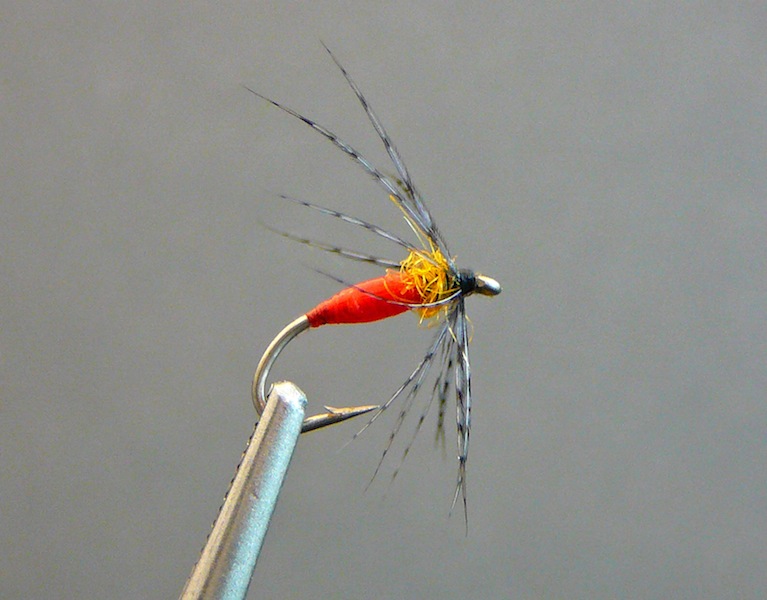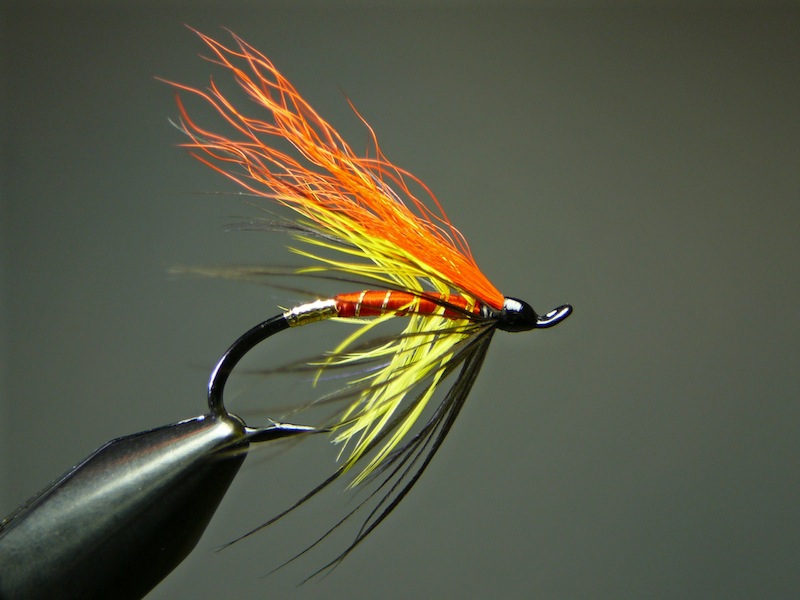Page 1 of 2
Lamplighter
Posted: Mon Dec 10, 2012 12:15 am
by Old Hat

- Lamplighter.jpg (98.36 KiB) Viewed 4047 times
This is a pattern derived from a local steelhead fly. I have been experimenting with some Partridge that I dyed a blue dun. I am having a heck of a time photographing the partridge to get it's true color. .
Anyway here it is.
Lamplighter
Hook: Gaelic Supreme's Syl Nemes Soft Hackle Wet Fly hook #15
Thread: Black Griffith's 14/0
Butt: flouro fire orange floss coated with laquer
Thorax: orange seal in a dubbing loop
Hackle: blue dun dyed partridge
Re: Lamplighter
Posted: Mon Dec 10, 2012 4:12 am
by Mataura mayfly
Outstandingly different, but visually appealing.

I have the same problem trying to photograph Pukeko to show its true colour, you have done well. Love the way you have taken a popular bigger fly and scaled/hackled it to suit another direction. With the floss being lacquered it should remain close to the colour we see it now once it becomes wet?
I like it, great photo and my kind of fly....... as you may soon discover if you have not twigged already through past postings of mine.

Re: Lamplighter
Posted: Mon Dec 10, 2012 12:18 pm
by Old Hat
Thanks, glad you like it.
Pukeko...hmmm... I have a little of that laying around, might look good on this pattern as well. I have tied a similar pattern to this with black seal in the thorax and a dark partridge or grouse hackle that is very productive.
Yes, the laquer soaks into the floss and really makes it translucent and durable. It retains the color you see here.
Here is one of the steelhead versions

- Lamplighter 2.jpg (99.45 KiB) Viewed 3986 times
Re: Lamplighter
Posted: Mon Dec 10, 2012 12:35 pm
by William Anderson
Good lord, these are amazing. The first does look like it would light a lamp, but that steelhead version. You'd be arrested for arson! Absolutely stunning.
w
Re: Lamplighter
Posted: Mon Dec 10, 2012 12:58 pm
by Old Hat
Thanks. Too kind William.
Re: Lamplighter
Posted: Mon Dec 10, 2012 2:31 pm
by letumgo
Carl - I've been studying the thorax of this fly (Thorax: orange seal in a dubbing loop), and was wondering if you could give me some pointers on getting the shape to look like yours. When I've tried seal in dubbing loop, it ends up being much more unruly (read WILD with crazy fibers emanating all over the place). How did you get it to behave so well? Really impressive flies, by the way. Flawless.
Re: Lamplighter
Posted: Mon Dec 10, 2012 2:43 pm
by Old Hat
Ray,
I pinch dub the seal onto the single strand of thread forming your standard noodle with my fingers slightly wetted as tight as I can, because as you said seal is difficult. I slide the dubbing up the thread until it just touches the point I want to start at. I then form a loop with the thread capturing the dubbing noodle and spin. This will form a nice tight capture and then you can pick it out at will.
Basically I'm capturing the dubbing noodle in the loop instead of fitting loose fibers in the loop and twisting.
Re: Lamplighter
Posted: Mon Dec 10, 2012 2:51 pm
by CreationBear
A couple of brookie hammers--great flies and photographs.

Re: Lamplighter
Posted: Mon Dec 10, 2012 2:58 pm
by letumgo
Thanks Carl, that is very helpful. Glad I asked.
Re: Lamplighter
Posted: Mon Dec 10, 2012 3:10 pm
by Mataura mayfly
Old Hat wrote:Ray,
I pinch dub the seal onto the single strand of thread forming your standard noodle with my fingers slightly wetted as tight as I can, because as you said seal is difficult. I slide the dubbing up the thread until it just touches the point I want to start at. I then form a loop with the thread capturing the dubbing noodle and spin. This will form a nice tight capture and then you can pick it out at will.
Basically I'm capturing the dubbing noodle in the loop instead of fitting loose fibers in the loop and twisting.
That is interesting, noodle in a loop must try that. As you say, seal can be difficult, but so can a tight crimp (crinkly) natural wool and possum tail. The tail fibres from an adult Aussie possum makes seal fur look like silk threads!

Almost as if each is charged negative ion and spend their life avoiding each other, fast as you twist it on it unravels behind you.
With seal I usually trap the first wrap, twist to tighten- take a wrap- twist again until the section is formed. Your way sounds quicker and easier.